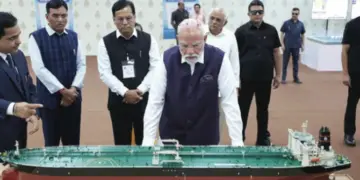On January 7, 2025, marking the ninth death anniversary of former Chief Minister Mufti Muhammad Sayeed, PDP President Mehbooba Mufti called for a renewed “healing touch” in Jammu and Kashmir. She emphasized that the current “graveyard silence” should not be mistaken for genuine peace and highlighted the need to restore the region’s lost identity and dignity.
The Healing Touch Policy (HTP), introduced by Mufti Muhammad Sayeed during his tenure from 2002 to 2005, aimed to address the alienation and grievances of the Kashmiri people through humane governance, rehabilitation of former militants, and reduction of security forces’ footprint. This approach sought to bridge the gap between the state and its citizens, fostering an environment conducive to peace and development. If you weigh the intention, there was nothing bad in the policy.
Mehbooba Mufti’s insistence on reviving HTP in its original form may not be the most effective solution for today’s challenges. Instead, a modernized, inclusive, and development-oriented approach that balances reconciliation with accountability and governance would be far more impactful in addressing the aspirations and grievances of the people of Jammu and Kashmir.
Why Could HTP in Its Previous Form Be Bad?
The socio-political dynamics in Jammu and Kashmir have shifted significantly since the introduction of the original HTP in 2002. The abrogation of Article 370 in 2019 has fundamentally altered the region’s legal and administrative framework, creating a new set of challenges and sentiments among the populace. Attempting to revive a policy designed for a vastly different context might fail to address the complexities of the current situation.
Moreover, a focus on measures such as releasing militants or reducing the presence of security forces could be perceived by some as an act of appeasement toward anti-national elements, potentially polarizing opinions further. This approach risks alienating victims of militancy, security personnel, and displaced communities like the Kashmiri Pandits, who may feel neglected or sidelined.
Mehbooba Mufti’s advocacy for the policy is also hampered by credibility concerns. Her tenure as Chief Minister (2016–2018) was marked by widespread unrest, particularly after the killing of Burhan Wani in 2016. Many view her leadership during that time as ineffective in balancing reconciliation efforts with maintaining law and order. As a result, her push for the HTP could be seen as an attempt to regain political relevance rather than a sincere effort to foster peacebuilding. Additionally, calling for its revival without offering concrete, updated strategies to reflect present-day realities risks reducing the policy to mere rhetoric, further diminishing its potential impact. Drafting a blueprint and making it public is a must. It must also be left open for people’s opinions and their incorporations if found feasible.
What All Needs to be Healed in Kashmir?
The data pileup of the past 35 years will speak up for itself, but PDP needs to clearly convey it to both people in the Union Territory and people in New Delhi empowered to listen and act affirmatively; given the assumption that there must be a saner way for Kashmiri politicians to take up critical issues of public importance with authorities in New Delhi. Such demeanor will certainly be seen as a silver lining in the clouds usually marred by ugly bickering prevalent in Indian politics these days. Over the past 35 years, Jammu and Kashmir (J&K) has witnessed significant numbers of detentions, primarily under the Public Safety Act (PSA) and other preventive detention laws. The PSA, enacted in 1978, allows for detention without trial for up to two years to prevent activities deemed prejudicial to the security of the state.
Estimates of Detentions Under the PSA:
-
- 1988 to 2015: Government records indicate that approximately 16,329 individuals were detained under the PSA during this period, with the vast majority from the Kashmir region.
- 1990 to 2010: Amnesty International estimated that between 8,000 to 20,000 individuals were detained under the PSA.
- 2016: Around 600 individuals were detained under PSA orders. Notably, the Jammu and Kashmir High Court annulled a significant number of these detention orders, highlighting concerns about the law’s application.
- August 2019 to March 2020: Following the abrogation of Article 370, the Union government informed the Rajya Sabha that a total of 5,161 individuals were detained, with 451 under the PSA as of March 2020.
- Alltime Data on Disappeared Children: Accurate data on the number of children who have disappeared in Jammu and Kashmir over the past 35 years is limited. However, the Association of Parents of Disappeared Persons (APDP) estimated that between 8,000 to 10,000 individuals have been subjected to enforced disappearances since 1989, with a significant number being young men, including minors.
- Orphaned Population: A 2012 study by Save the Children found that the conflict is responsible for 37% of Kashmir’s 200,000 orphans, indicating the profound impact of the ongoing conflict on children. These figures highlight the pressing need for comprehensive measures to address the issue of missing children and provide support to affected families in the region.
Since issues as given remain widely unresolved, the relevance of HTP is both significant and complex. Repackaging and reintroducing HTP could serve as a catalyst for rebuilding trust between the PDP, the people, and the Centre. However, a mere replication of past strategies may not suffice. A rebranded approach, tailored to address contemporary challenges, is essential.
How and What Should Be the Way Forward?
The path to a stable, peaceful, and thriving Jammu and Kashmir lies in crafting a policy framework that rings well with the aspirations of its people while aligning with the strategic interests of New Delhi.
- Building Trust Through Meaningful Dialogue: The foundation of any lasting solution lies in dialogue. This process should also include marginalized groups, such as displaced Kashmiri Pandits and families of conflict victims, ensuring that no one feels excluded. The dialogue must address both political grievances and socio-economic aspirations while maintaining the region’s constitutional status quo, post-Article 370 abrogation. The dialogue must discuss and set measurable goals, and avoid useless banter.
- Rehabilitating Conflict Victims: The conflict has left behind a legacy of orphans, widows, and displaced families, all of whom need targeted rehabilitation. New Delhi can establish a Kashmir Conflict Rehabilitation Commission tasked with providing legal, financial, and psychological support to affected families. PDP, having founded the HTP, can act as a pivot back and forth.
- Restoring Cultural and Regional Identity: A major grievance among Kashmiris has been the perceived erosion of their cultural and regional identity. To address this, the government can establish platforms to celebrate Kashmiri heritage, art, and language. Reviving Sufi traditions and interfaith dialogue can promote communal harmony and counter radical ideologies. All Kashmiris – Muslims, Pandits, Sikhs, and even Christians (even if minuscule) must be the participants in such an initiative.
- A Collaborative Approach: The blueprint for Kashmir’s healing must be co-owned by the Union government and the local populace/parties. Regular consultations with Kashmiri leaders, civil society, and youth groups, alongside development-focused interventions, would create an environment of mutual respect and cooperation. There is a huge trust deficit on either side.
The Way Forward: The way forward for Kashmir is not an either-or choice between security and reconciliation. It is about integrating these elements into a comprehensive framework that respects the aspirations of the Kashmiri people while maintaining the unity and sovereignty of India. A rebranded HTP, grounded in economic revival, cultural preservation, and political inclusivity, can serve as the bridge between New Delhi and Srinagar. If crafted and implemented with sensitivity and vision, this new HTP blueprint can transform the valley from a symbol of discord into a beacon of hope for reconciliation and growth. And PDP – from being seen earlier as a “collaborator with BJP” – can be seen as an “honest facilitator” with the party for Kashmir’s growth and Kashmiri’s progress.




